Hello from the state of Oregon! I'm a self-providing guerrilla grower, I go to great lengths to keep my grows unconnected to me, this means hiking deep into the isolated corners of my local area to grow my bud.
This thread is meant to document my journey to the grow seasons start in spring. Feel free to ask questions, as long as it concerns cultivating Cannabis, I'm happy to help if I can.
Any ways, I'm BACKCOUNTRY, I've been posting on the boards since I joined overgrow.com in 2004, I survived OGs demise and poped up here in 2006.
As many know, my climate is extremely dry in summer, my average rainfall for May-Sept is 3.5", with most of that falling in May. Most of the work and concern in a normal season revolves around watering plants, the difference between a good harvest and a bad harvest has direct relation to how much water was provided. Under watered plants never get very large, and have small harvests.
Last season I experimented with a passive irrigation system that I call the Earth hole:
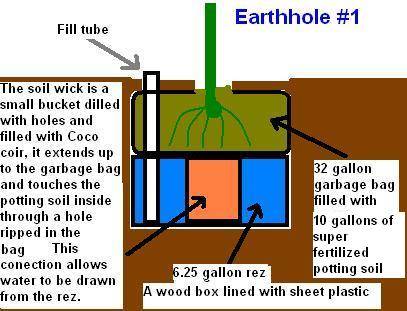
The purpose of the Earth hole is to provide totally reliable irrigation for one plant, the Earth holes I build for 2010 will all hold 21 gallons of water, and will be able to extend my visits from once or twice a week all summer watering by hand, to once every 3 weeks to refill the Earth holes reservoir.
Here is a link to my old Earth hole thread- Earth holes: A experiment in Guerrilla irrigation
Here is a link to my 2009 grow thread- Oregon Organic Guerrilla 2009, with your host BACKCOUNTRY
Based on my 2009 season, it appears I'll need 90 gallons of water for each plant. I'd like to select places to grow that are very difficult to visit, places that require log hikes from any direction. These kinds of places don't have water in the summer, even in the rainy season there is no running or sitting water to be found in these high-dry places, and I sure as heck ain't gonna haul it there on my back!
The solution to the problem is to use rain harvesters to collect the water on site. As the rain falls, it is collected by a tarp strung between trees, and aimed so the water collects in a reservoir of some kind.
My rainy season is strongest from December to February, during this period nearly 75% of my total rainfall comes. So I am getting to work building rain harvesters.
Here is a rain harvester I used last winter-
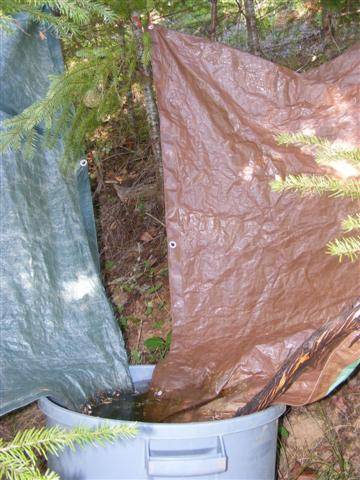
Today I took a walk to a high ridge out in the hills, the place I was nearly a mile from the nearest parking spot. Very pretty Douglas fir forests and such.
At one point I happened upon a grove of Pacific Madrone and Mazanita-
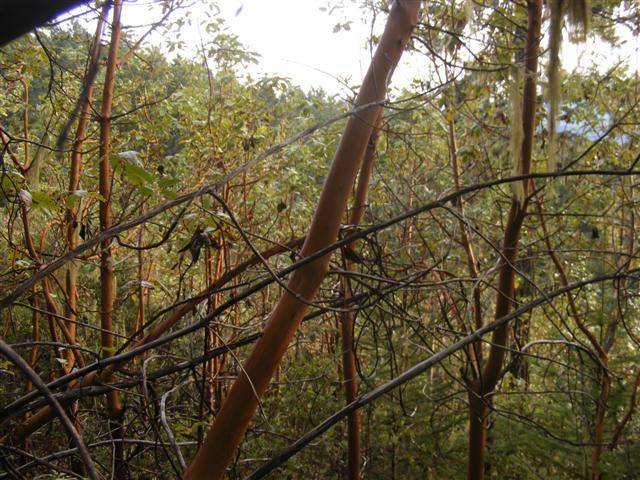
As you can see, this is a thick place, all the trees are young Madrone, some are kind of tall, but there are many holes in the canopy to allow light in. Manzanita, a type of shrub closely related to Madrone, grows in the understory, blocking clear views outside of small clearing you stand in.
A perfect place to hide some Guerrilla plants.
Today was a rare sunny day, the fog we have been under for days finally burned off. Late in the afternoon I was able to find time for my scouting trip. I mostly just anticipated scouting, so I took a compass and my camera, as a last minute thought I decided to take some sheet plastic and some zip-ties, in case the spot turned out to be good I thought I might make a crude rain harvester and get a jump on preparations!
I started by piling some rotten logs in a log cabin shape, I used my hunting knife to knock off any twigs that might poke holes in the plastic I'll lay over next-
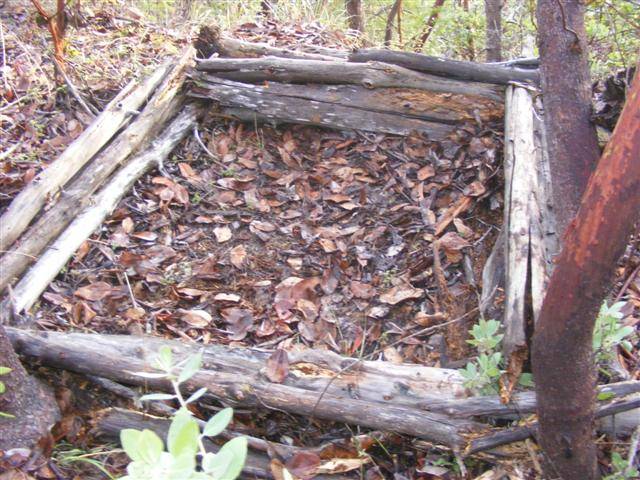
Next I laid the single piece of plastic onto the structure, weighing it down with more pieces of log. The tail end of the piece was ziptied to two trees behind the reservoir part-
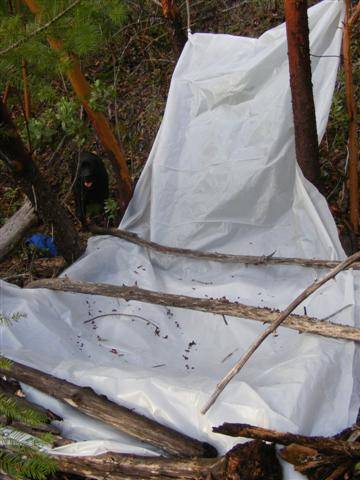
This took me 15 minutes to build, and should catch 80-100 gallons in the next month or so, enough for one plant. I carried the plastic in a small backpack(like kids take to school), it was light to carry. I'll build these anywhere I find a good spot, then I'll come through and build more permanent reservoirs to store the water through summer, straining the dirt and debris from it as I transfer the water.
Anyways, I'll be back here and there to update my progress, should be lots of posts concerning collecting and storing water, building earth holes, and getting plants ready for planting.
This thread is meant to document my journey to the grow seasons start in spring. Feel free to ask questions, as long as it concerns cultivating Cannabis, I'm happy to help if I can.
Any ways, I'm BACKCOUNTRY, I've been posting on the boards since I joined overgrow.com in 2004, I survived OGs demise and poped up here in 2006.
As many know, my climate is extremely dry in summer, my average rainfall for May-Sept is 3.5", with most of that falling in May. Most of the work and concern in a normal season revolves around watering plants, the difference between a good harvest and a bad harvest has direct relation to how much water was provided. Under watered plants never get very large, and have small harvests.
Last season I experimented with a passive irrigation system that I call the Earth hole:
The purpose of the Earth hole is to provide totally reliable irrigation for one plant, the Earth holes I build for 2010 will all hold 21 gallons of water, and will be able to extend my visits from once or twice a week all summer watering by hand, to once every 3 weeks to refill the Earth holes reservoir.
Here is a link to my old Earth hole thread- Earth holes: A experiment in Guerrilla irrigation
Here is a link to my 2009 grow thread- Oregon Organic Guerrilla 2009, with your host BACKCOUNTRY
Based on my 2009 season, it appears I'll need 90 gallons of water for each plant. I'd like to select places to grow that are very difficult to visit, places that require log hikes from any direction. These kinds of places don't have water in the summer, even in the rainy season there is no running or sitting water to be found in these high-dry places, and I sure as heck ain't gonna haul it there on my back!
The solution to the problem is to use rain harvesters to collect the water on site. As the rain falls, it is collected by a tarp strung between trees, and aimed so the water collects in a reservoir of some kind.
My rainy season is strongest from December to February, during this period nearly 75% of my total rainfall comes. So I am getting to work building rain harvesters.
Here is a rain harvester I used last winter-
Today I took a walk to a high ridge out in the hills, the place I was nearly a mile from the nearest parking spot. Very pretty Douglas fir forests and such.
At one point I happened upon a grove of Pacific Madrone and Mazanita-
As you can see, this is a thick place, all the trees are young Madrone, some are kind of tall, but there are many holes in the canopy to allow light in. Manzanita, a type of shrub closely related to Madrone, grows in the understory, blocking clear views outside of small clearing you stand in.
A perfect place to hide some Guerrilla plants.
Today was a rare sunny day, the fog we have been under for days finally burned off. Late in the afternoon I was able to find time for my scouting trip. I mostly just anticipated scouting, so I took a compass and my camera, as a last minute thought I decided to take some sheet plastic and some zip-ties, in case the spot turned out to be good I thought I might make a crude rain harvester and get a jump on preparations!
I started by piling some rotten logs in a log cabin shape, I used my hunting knife to knock off any twigs that might poke holes in the plastic I'll lay over next-
Next I laid the single piece of plastic onto the structure, weighing it down with more pieces of log. The tail end of the piece was ziptied to two trees behind the reservoir part-
This took me 15 minutes to build, and should catch 80-100 gallons in the next month or so, enough for one plant. I carried the plastic in a small backpack(like kids take to school), it was light to carry. I'll build these anywhere I find a good spot, then I'll come through and build more permanent reservoirs to store the water through summer, straining the dirt and debris from it as I transfer the water.
Anyways, I'll be back here and there to update my progress, should be lots of posts concerning collecting and storing water, building earth holes, and getting plants ready for planting.





 for being you!
for being you! 

